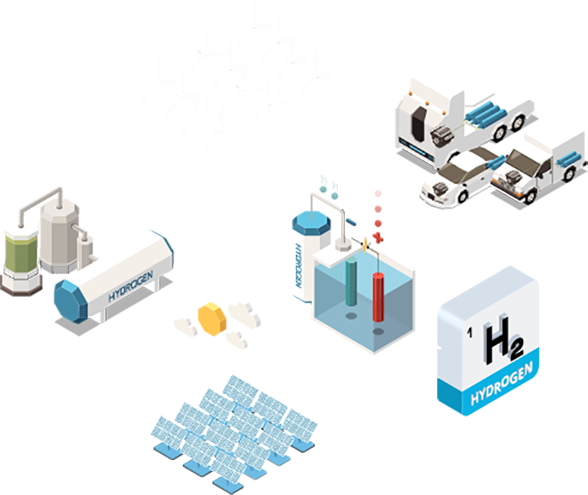Leading the
Green Hydrogen Revolution
The only way to succeed in our sustainable future is to partner with the best
LEARN MOREA 100 Per Cent Renewable Energy Future Is Now a Reality
Discover how Sigma can help you and your organization be ready and profit from our decarbonized future with green hydrogen.
Sigma is setting the benchmark for hydrogen generation for the future. By 2030, we are expected to reach fossil fuel parity prices with green hydrogen, bringing it to a massive global scale.
CONTACT US

The Future Is Now
The only net-zero fuel source is green hydrogen emitted by electrolysers and generated through renewable energy sources. With no negative impact on air quality while maintaining the earth’s existing water and oxygen balance.
The fuel of the future is just around the corner and the early adopters will be able to get massive first-mover advantages and become key market players. Several countries and industry sectors have completely pledged to achieve net zero emissions, green hydrogen is the fuel of now.
LEARN MOREExplore Solutions by Industry
Discover how Sigma can help you and your organization be ready and profit from our decarbonized future with green hydrogen.




















Sigma is enabling real change
If you want to join the green hydrogen revolution, Sigma is here for you regardless of the size of your enterprise. Whether you are an investor, a small enterprise, a large-scale industry, or a corporation we can assist you.
CONTACT USFrequently Asked Questions
Common questions on hydrogen and its applications
What is hydrogen?
Is hydrogen an unusual element?
What temperature causes hydrogen gas to become liquid?
What is the energy content of hydrogen in comparison to other fuels?
How can hydrogen's stored energy be used?
Do we have sufficient experience producing and utilizing hydrogen?
How is hydrogen produced?
What methods of producing hydrogen are available today?
How is hydrogen stored?
Why is hydrogen compression or liquefaction required?
What are the most prevalent pressures in compressed gas storage?
How does hydrogen get from point A to point B?
Is hydrogen harmful or toxic?
How harmful is hydrogen use?
What steps are being taken to avoid the creation of an explosive hydrogen-air mixture?
Is it correct that hydrogen could not be safely stored?
What are the risks of a hydrogen gas leak?
What is the process of electrolysis?
What types of electrolysis systems are there?
What exactly does ALK stand for?
What are the distinctions between electrolysis systems?
Alkali: OH-
PEM: H+
SOE: O2-.
How much energy is required to produce one kilogram of hydrogen using electrolysis?
Which industries make extensive use of hydrogen?
• Power Generation
• Stationary Fuel Cells
• Power to Gas
• Methanation and many more...
What are the current industrial applications for hydrogen?
How much hydrogen is needed to drive 100 kilometers in a medium-sized car?
What amount of time does it require to refuel an energy unit electric vehicle?
What are the particular benefits of consolidating power from sustainable power sources and hydrogen?
Is hydrogen merely a short-term solution?
What are the primary components of the hydrogen generation energy mix?
What exactly are 'green,' 'grey/brown,' and 'blue' hydrogen?
Sigma ALK Electrolyser
Producing enough hydrogen requires innovative solutions with our Sigma ALK electrolyser, an innovative ALK alkaline electrolysis system that uses wind and solar energy to produce hydrogen and is completely CO2-free. From initial planning to full operation with equipment on site, we can have you operational in as little as 4 months.
Advantages compared to PEM water electrolysis.
In comparison to polymer electrolyte water electrolysis, the advantages of alkaline water electrolysis are mainly:
- Cheaper catalysts with respect to the platinum metal group-based catalysts used for PEM water electrolysis.
- Higher durability due to an exchangeable electrolyte and lower dissolution of anodic catalyst.
- Higher gas purity due to lower gas diffusivity in alkaline electrolytes.
CONTACT US
GET IN TOUCH WITH OUR TEAM
Questions? The Sigma team is here for you. No matter in what country you are located, we are here to assist you. Please use the contact form below to contact us or alternatively call us at:

LOCATION
Rua Dr Justino Cruz 110
Braga, 3700-314
Portugal
PHONE
+13104022562
+13104022562
ABOUT SIGMA
Sigma is the Global
Leader in Green Hydrogen Solutions
As an absolute believer in our green fully decarbonized future, our firm was founded with the principle of being the world's leading green hydrogen service provider. We believe from 2025 to 2050 a new world will emerge, and green hydrogen will be one of its foundational cores.

The fossil fuels era is soon to be extinct
The early adopters of green energy specifically green hydrogen will be positioned to become market leaders.
GET STARTEDWith possibilities beyond our wildest imagination, the world ahead is not an extension of the past. There will be massive changes as yesterday's solutions cannot solve the problems of tomorrow. In the next decades, every foundational sector of the economy will experience massive change, and energy and technology will see the biggest revolutions.
Sigma is where aspiration meets innovation we are dedicated to building and delivering green hydrogen solutions that not only create extreme value but also deliver lifelong sustainability.
We are heading towards a brand new prosperous, resilient, and equitable energy system. Sigma is your partner in this new journey that lies ahead.

